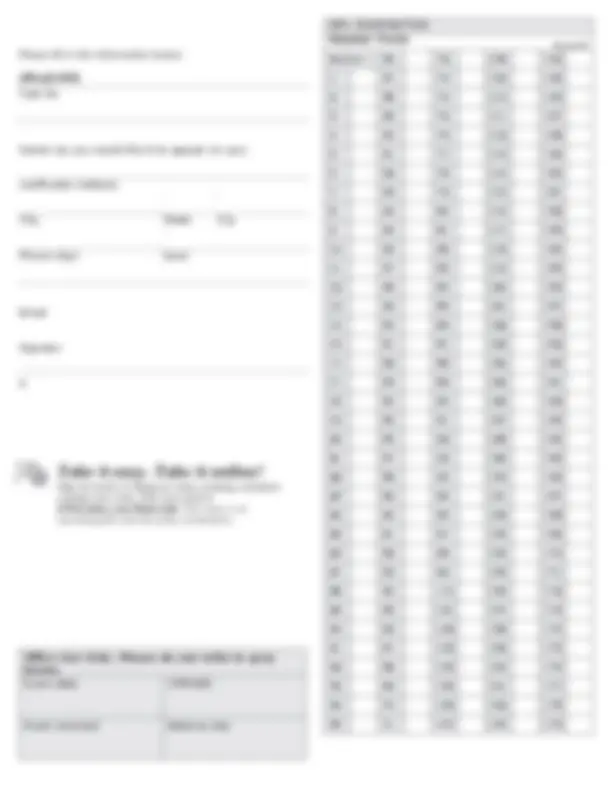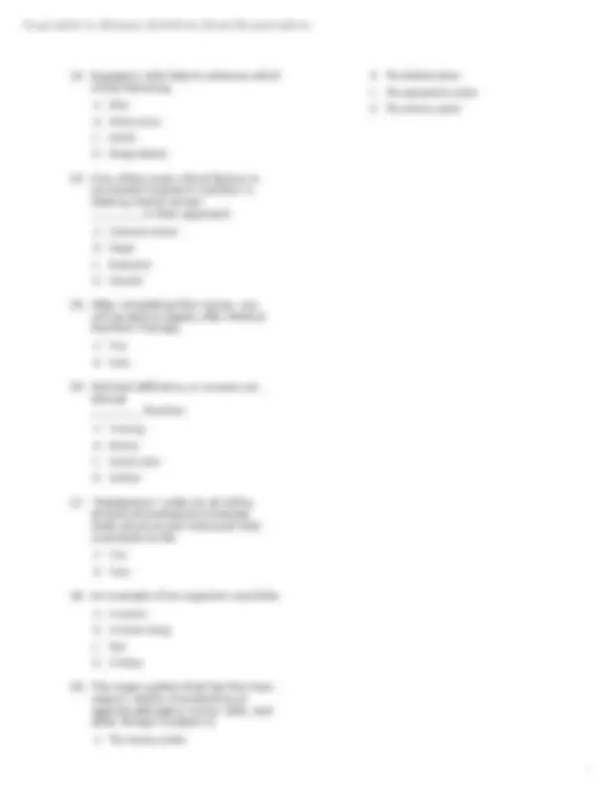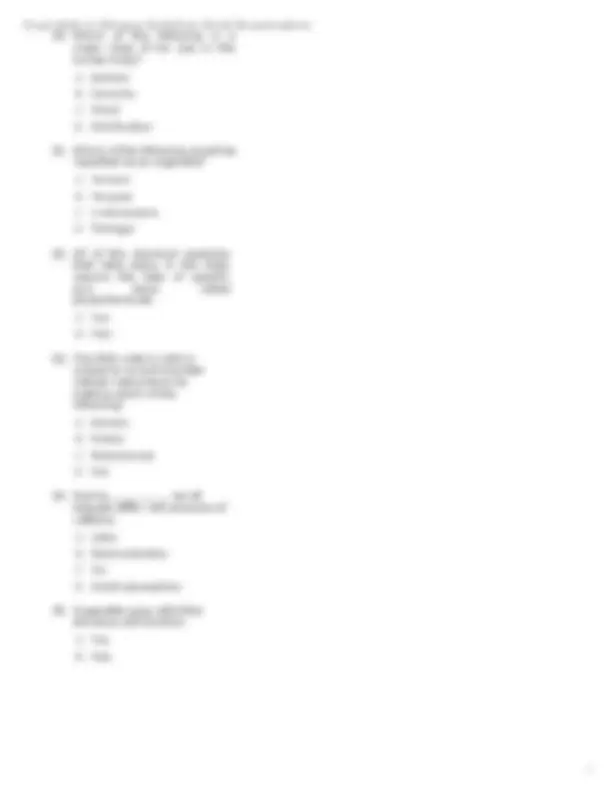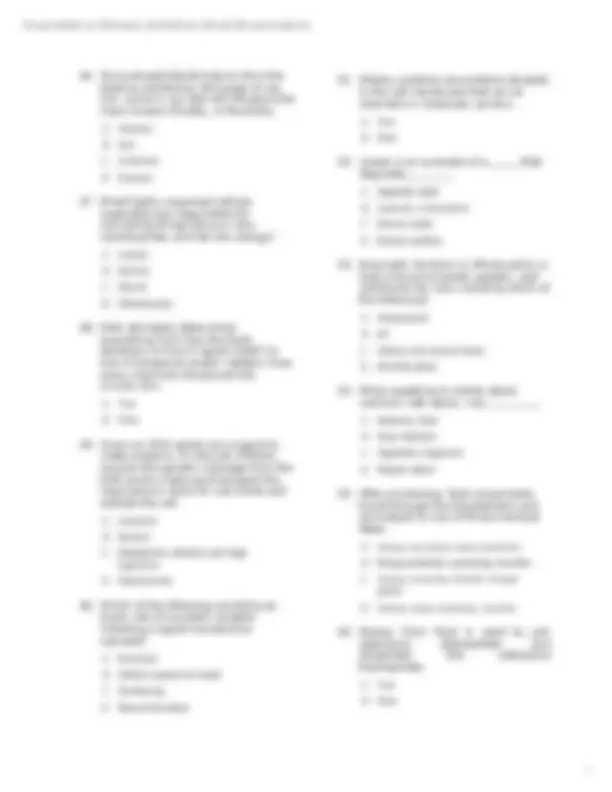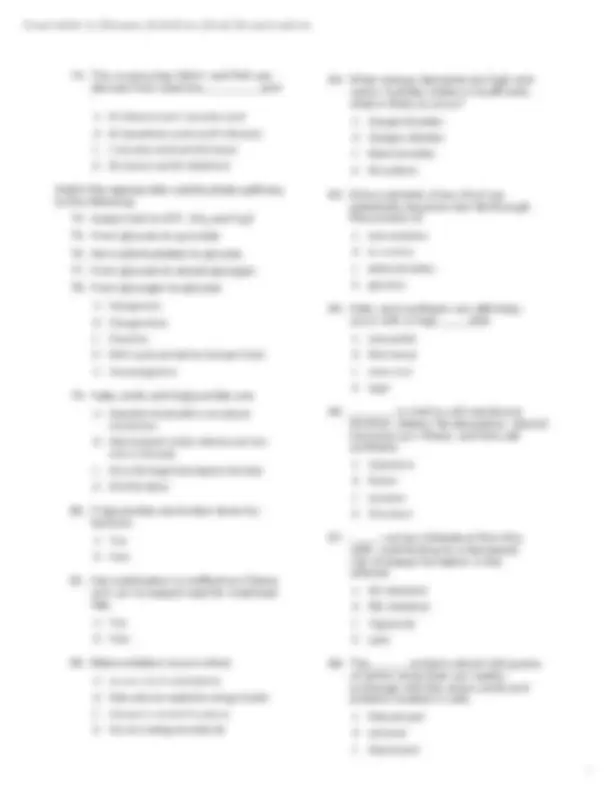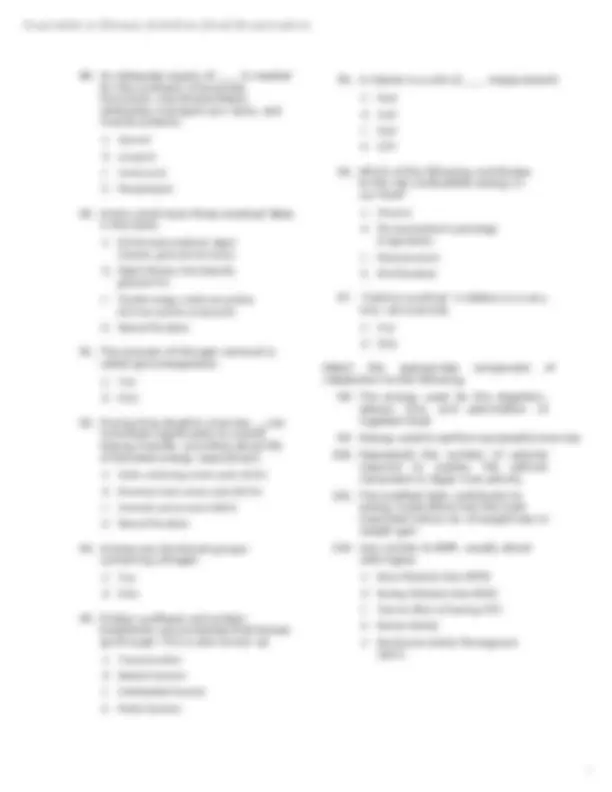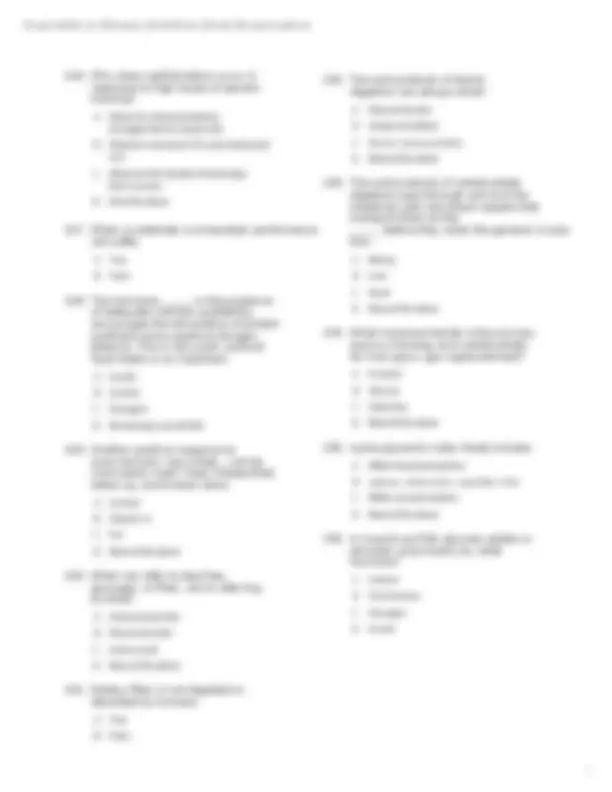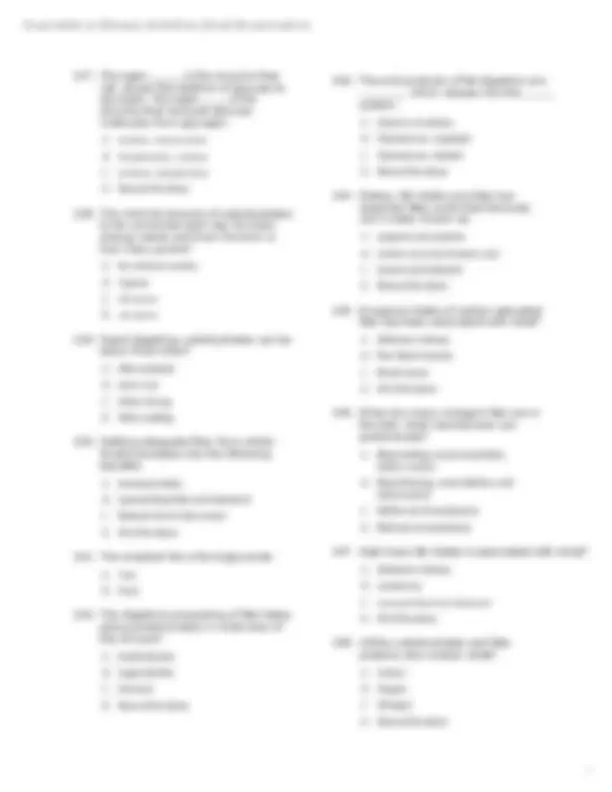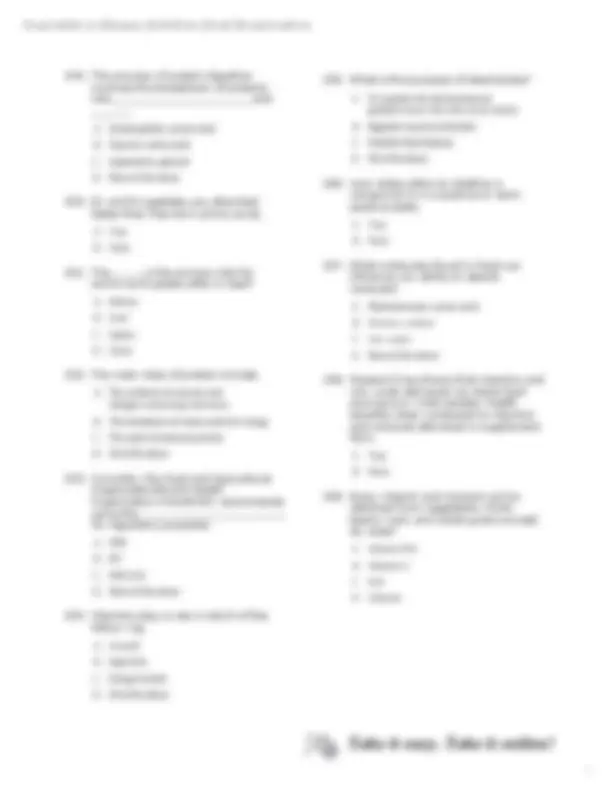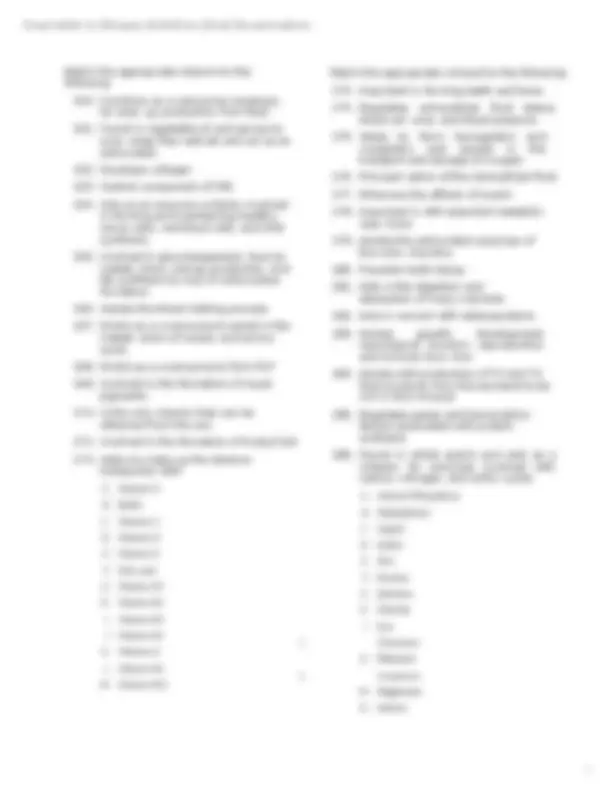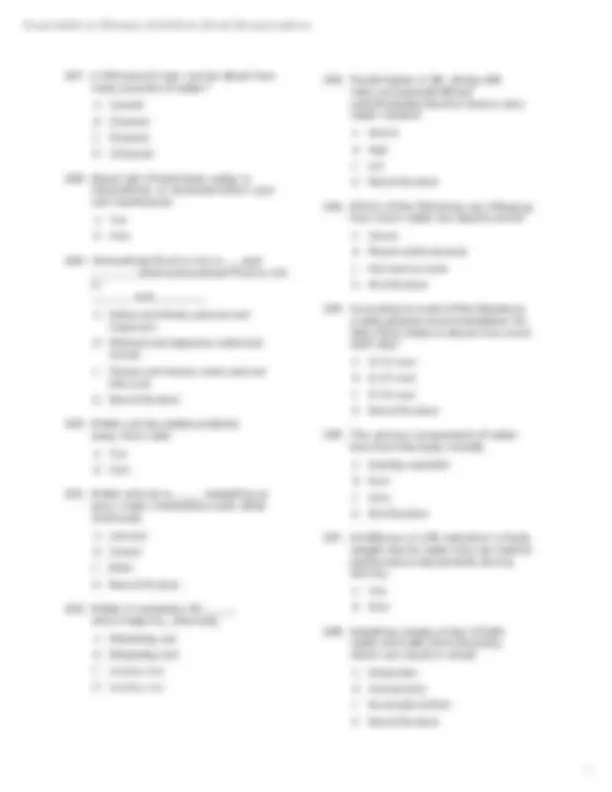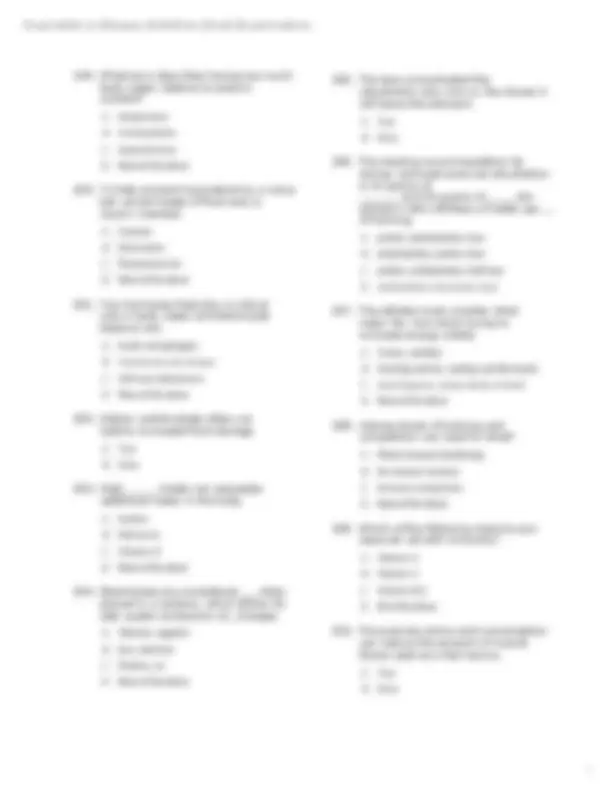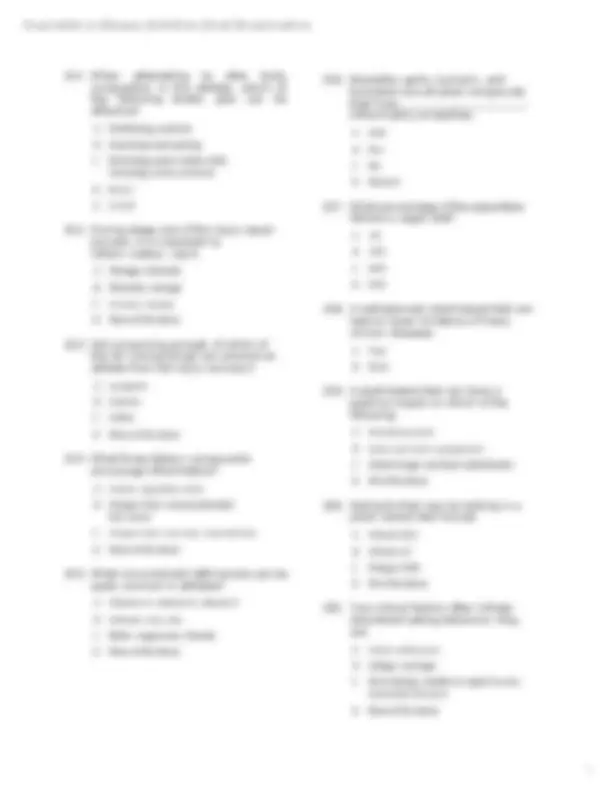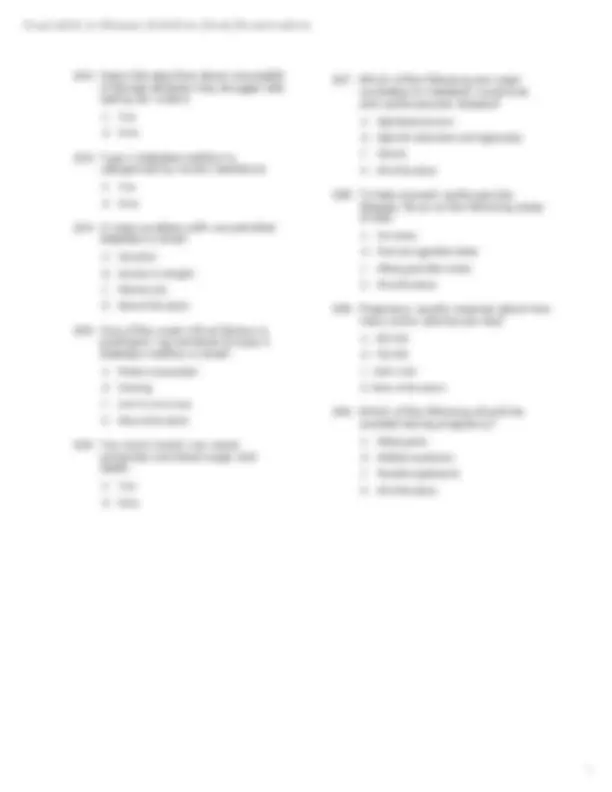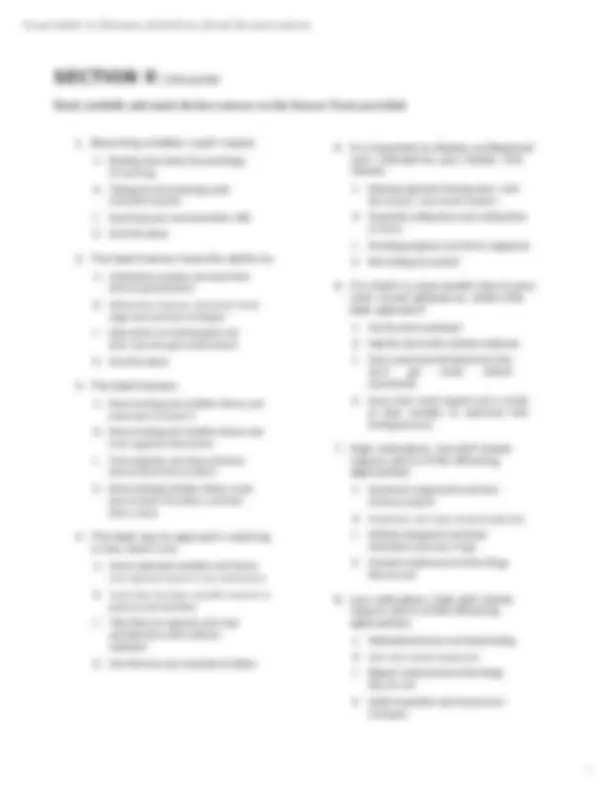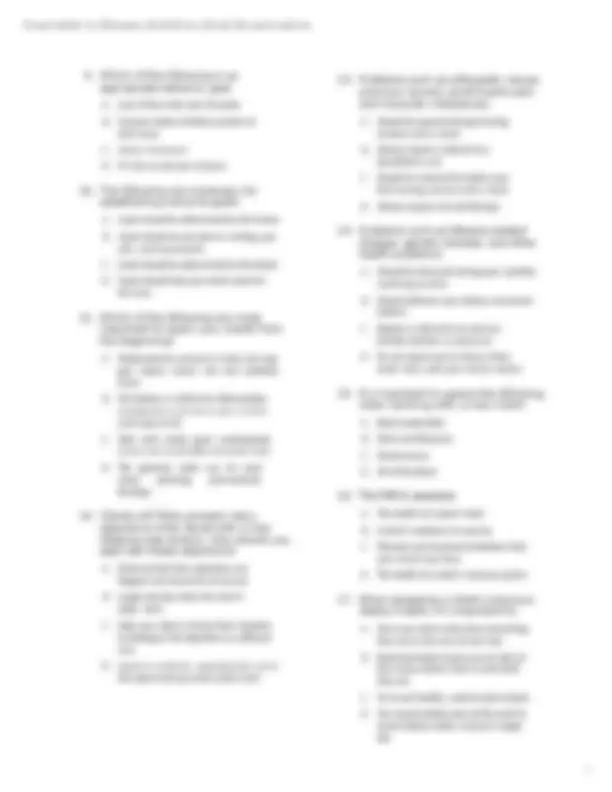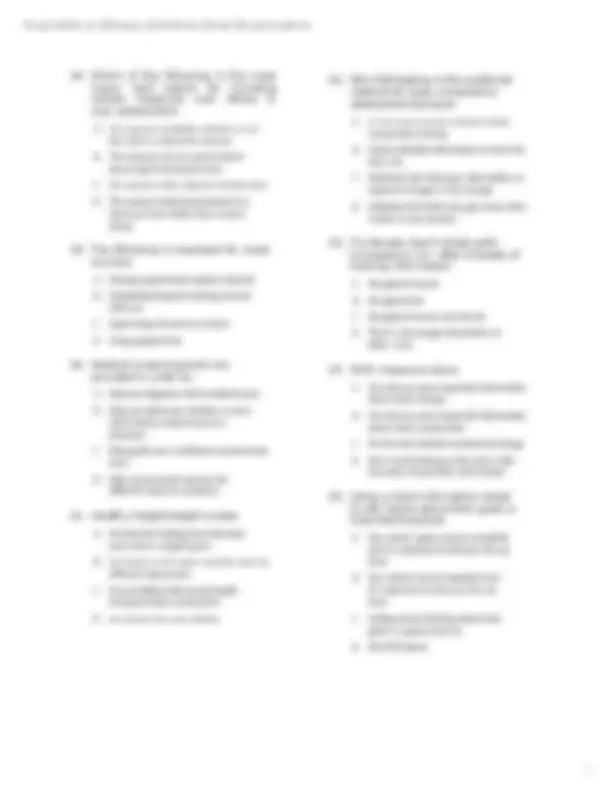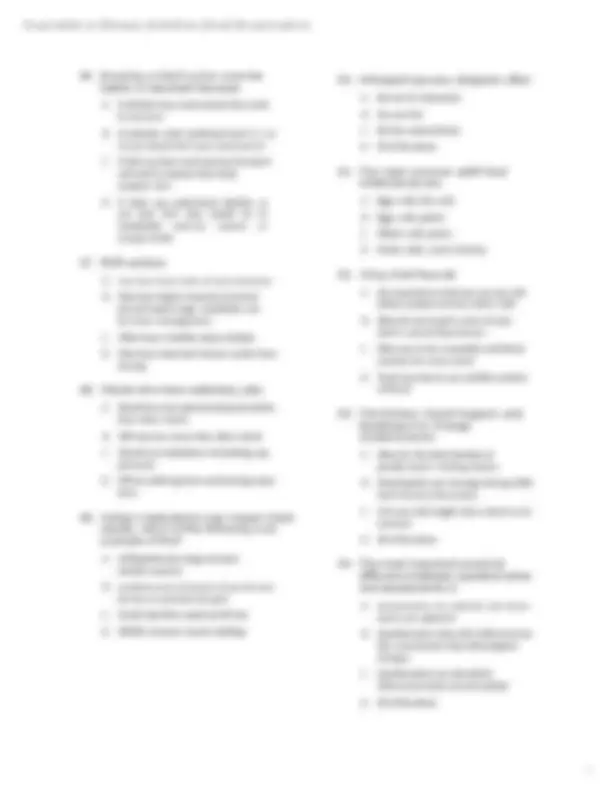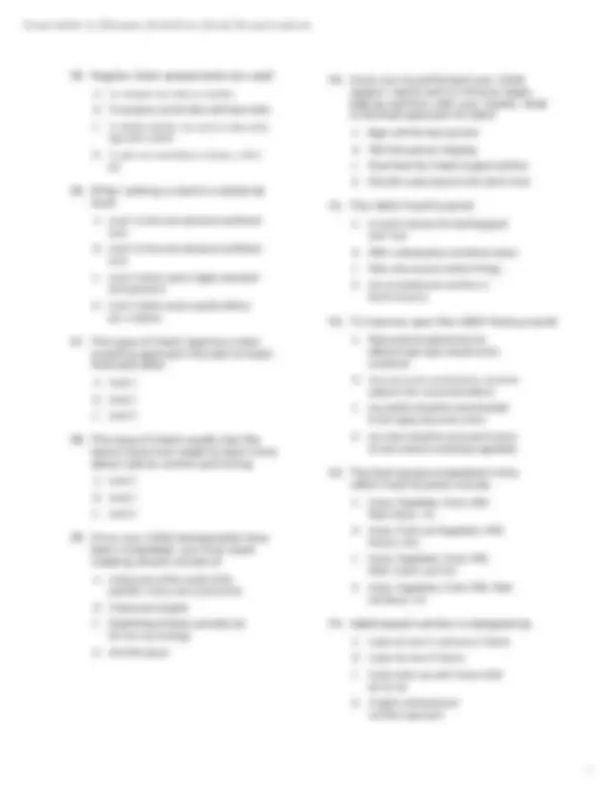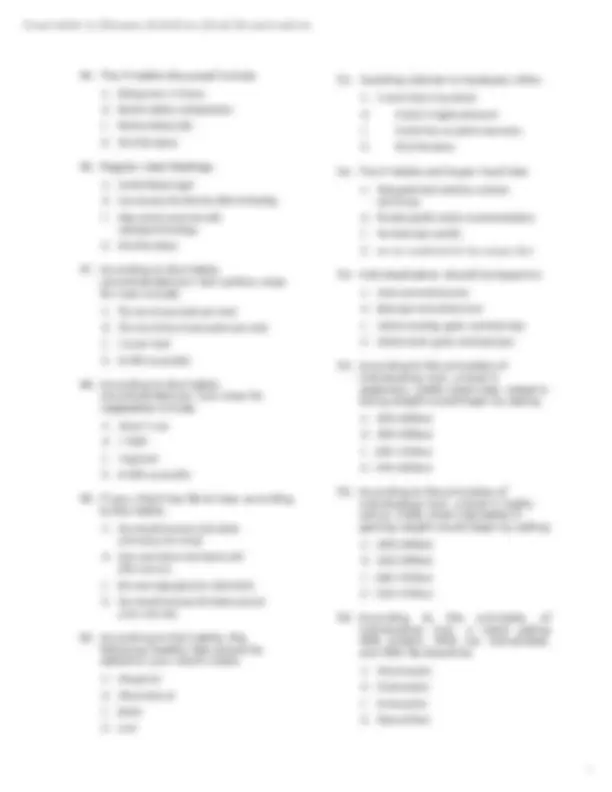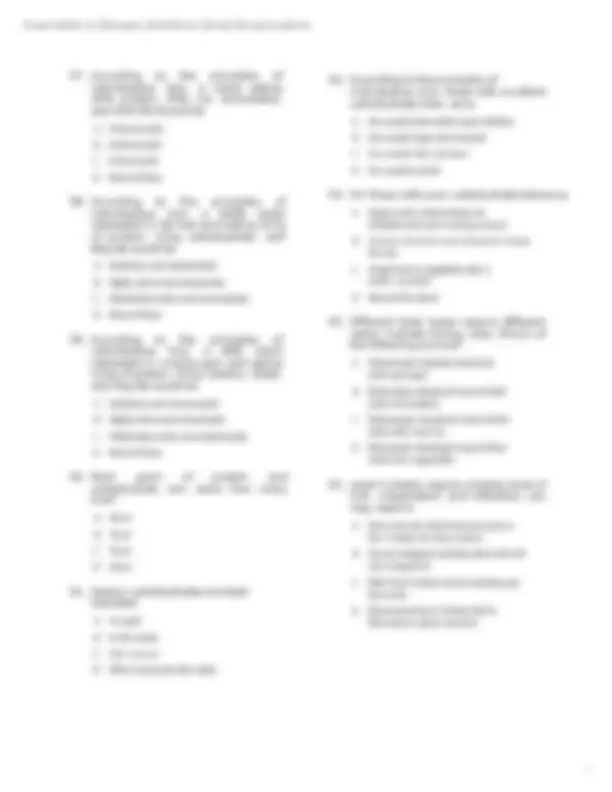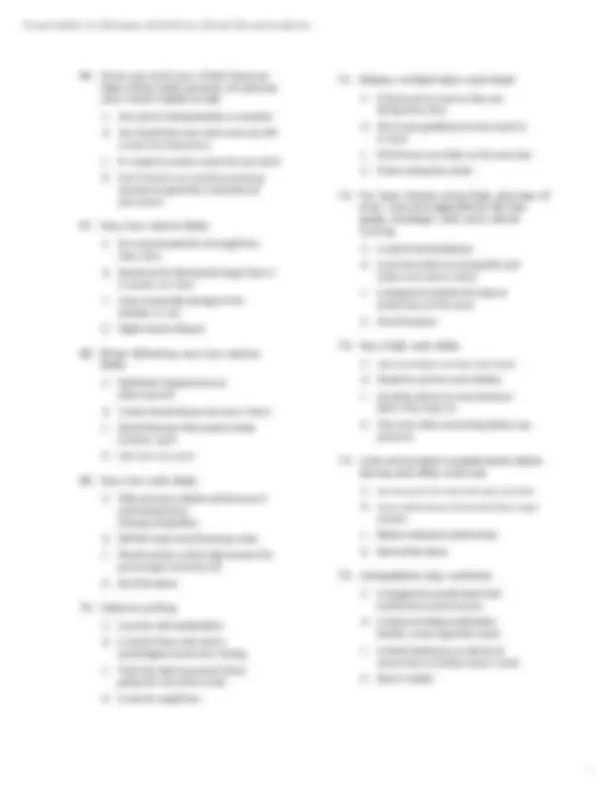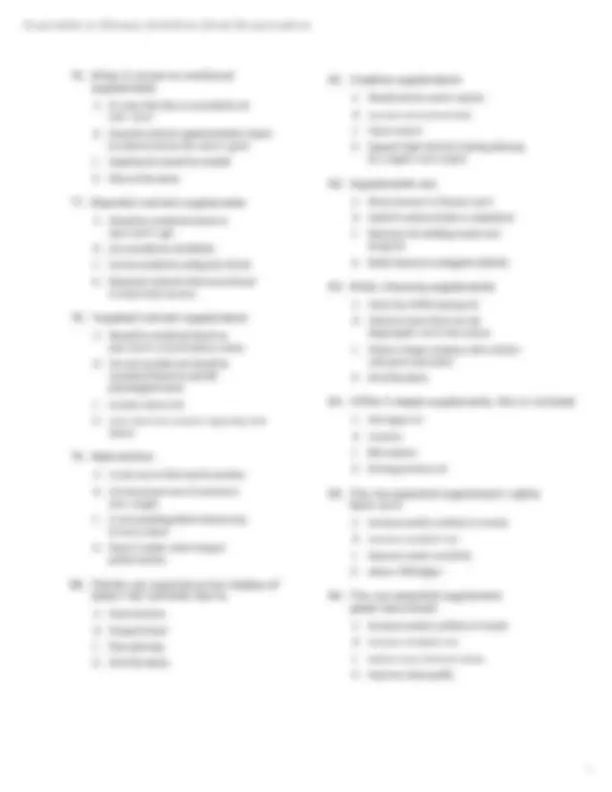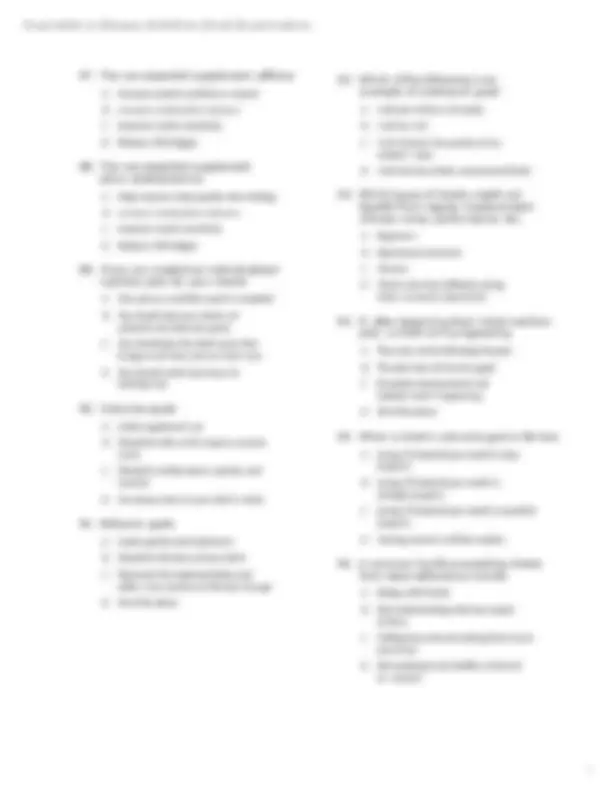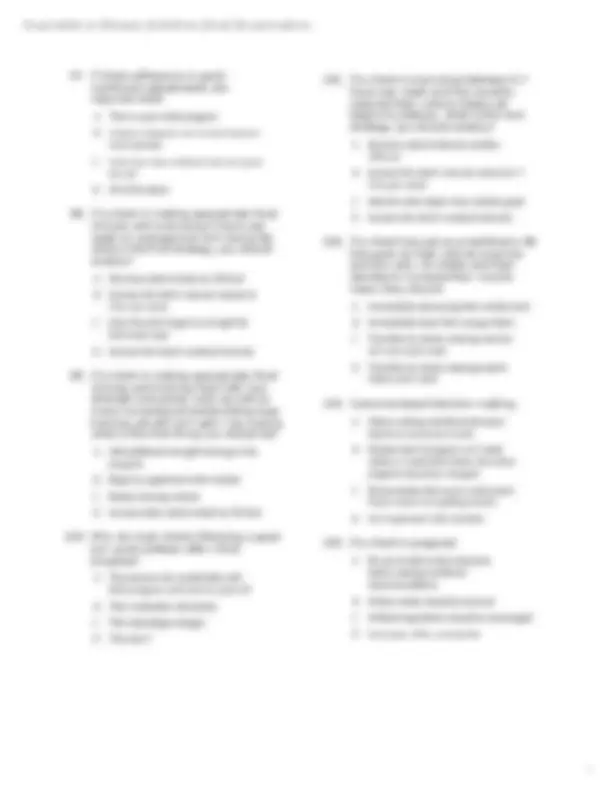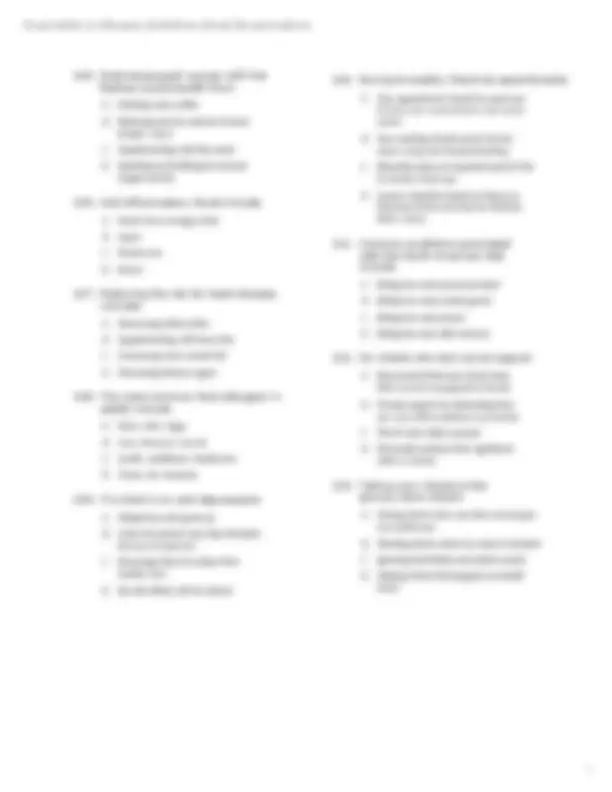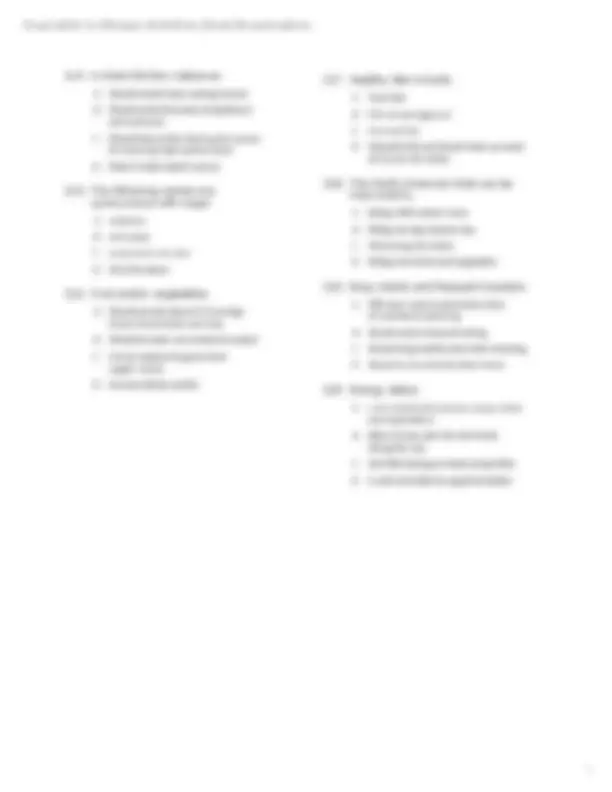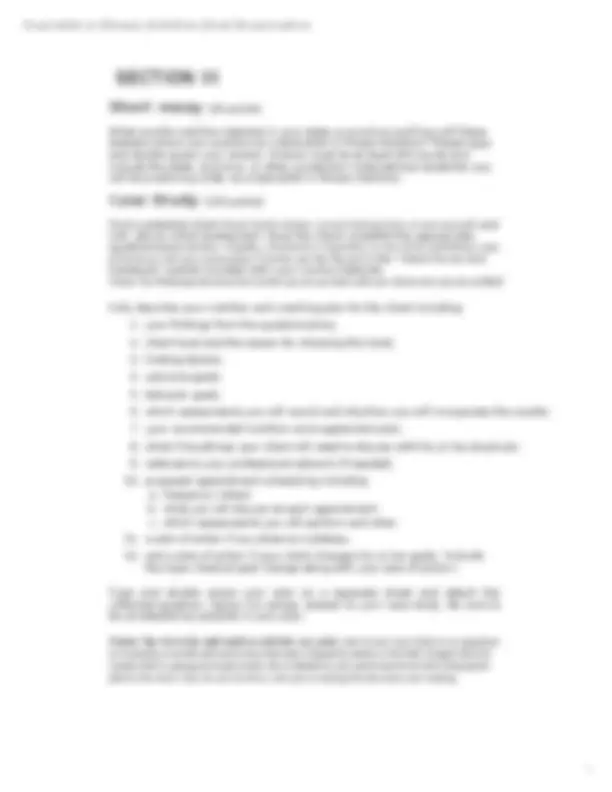Download ISSA Fitness Nutrition Certification: Final Exam Assessment and more Exams Nursing in PDF only on Docsity!
Specialist in
Fitness
Nutrition
OFFICIAL FINAL EXAMINATION
Take it easy. Take it online!
Skip the hassle of photocopies, staples, and registered mail. Take your exam at ISSAtrainer.com.
Please note : This exam is not interchangeable with the online examination.
Contents
Section I: 230 multiple choice Section II: 120 multiple choice Section III: 1 short answer 1 case study sfn_exa_ Artwork displayed in this document is the property of the International Sports Sciences Association and cannot be reproduced in any form. * Please note : This exam is not interchangeable with the online examination.
Your final examination consists of three sections:
SECTION I: 230 multiple choice
SECTION II: 120 multiple choice
SECTION III: 1 short essay and 1 case
study
Record your answers to Section I and Section II on
the provided answer form. You may use pencil or
pen. Your short essay and case study must be typed,
spell-checked, and organized according to the direc-
tions below.
The total point value of the entire exam is 500
points. A passing score of 75% or better is required
on each section of the exam. Certification will be
granted only when all sections have been completed
with a passing score. Any student who receives a non-
pass- ing score on a section of the exam will be
notified and given an opportunity to re-do that
section.
Directions for submitting your SFN examination
Submit a copy of this form along with your final
examination. Any exam submitted without this
form will be returned.
1. TYPE A COVER PAGE with only the
follow- ing information:
_- Name as you wish it to appear on your certificate
- Current mailing address
- Current phone number
- Current email address_
2. ARRANGE THE CONTENTS OF
YOUR EXAM in the following order
from first to last: _1) This signed direction sheet
- Cover page, typed
- SFN Answer Form
- Short essay, typed (250-word minimum)
- Case study, typed (lengths vary)
- Questionnaires and other data gathered for your case study (no client names, please)
- Proof of CPR/AED Certification – photo copy, front and back_
3. STAPLE YOUR ENTIRE EXAM
TOGETHER. If your exam is too large, clip
it together with an extra large paper clip or binder clip. DO NOT include: plastic sheet covers, spiral bound exams, binders, etc.
4. DO NOT SEND IN PARTS OF YOUR
EXAM. Send all parts of the exam in
together, to prevent any delay in processing your exam due to missing or lost items.
5. RETAIN A COPY OF YOUR ENTIRE
EXAM FOR YOUR RECORDS. In the
event your exam is lost in transit, you are responsible for having a copy of your exam to re-submit.
6. MAIL YOUR EXAM. DO NOT FAX
OR EMAIL. Send your exam via the
postal service or other express mail service to: ISSA Professional Division ATTN: Testing 1015 Mark Avenue Carpinteria, CA 93013 ISSA strongly recommends using a traceable method to ship your exam (Fed Ex, UPS, regis- tered mail, etc.). ISSA will not confirm receipt of examinations.
By signing this form I attest that I have completed this examination on my own, that the exam has been organ-
ized as outlined above, and that I have retained a copy of the exam for my records. I understand that ISSA will
return my exam to me to if I have not submitted a complete or properly organized examination.
Signature Date
Please fill in the information below: sfna Test No. Name (as you would like it to appear on your certificate) Address City State Zip Phone (day) (eve) Email Signatur e Take it easy. Take it online! Skip the hassle of filling out forms, printing, and photo- copying your work. Take your exam at ISSAtrainer.com Please note : This exam is not interchangeable with the online examination. Office Use Only. Please do not write in gray boxes. Exam date CPR/AED Exam received Balance due
SFN EXAMINATION
Answer Form sfn_exa_
Section I 36. 72. 108. 144.
**1. 37. 73. 109. 145.
23 59. 95. 131. 167.
- 179.**
Seminar code Entered by
SECTION I (230 points) Read each question carefully and mark the best answer on the Answer Form provided.
- The three major limiting factors for clients include genetic makeup, physical activity patterns, and nutritional habits. A. True B. False
- The phrase “energy balance” represents the relationship between: A. Energy in and energy in B. Energy in and energy out C. Energy out and energy out D. Energy from food and energy from exercise
- A positively or negatively skewed energy bal- ance can influence which of the following: A. Metabolism B. Mood C. Hormonal balance D. All of the above
- Consequences of a negative energy balance include: Plaque buildup on arteries, increases in blood pressure, and insulin resistance. A. True B. False
- Reproductive function, metabolic function, and brain function may “slow-down” dur- ing: A. Negative energy balance B. Neutral energy balance C. Positive energy balance D. Overfeeding
- Good nutrition programs can help to prop- erly control energy balance. A. True B. False 7. Which of the following statements is true in regard to nutrient density? A. It’s the balance between food and exercise B. It can’t be influenced by one’s nutrition program C. Nutrient dense foods are generally highly processed foods D. It’s the ratio of nutrients relative to the total calorie content in a food 8. Calorie density is the ratio of calories to the actual weight of a food. A. True B. False 9. Foods with low calorie density can include: A. Reduced calorie snacks and pretzels B. Butter and bacon C. Cookie and crackers D. Vegetables, fruits, broth based soups
- Foods with high nutrient density and low calorie density are regularly over- consumed and lead to excess body fat. A. True B. False
- Good nutrition takes into account: A. Body composition B. Health C. Performance D. All of the above
- Focusing exclusively on body composition when making nutrition choices is always healthy. A. True B. False
- Ergogenic aids help to enhance which of the following: A. Diets B. Performance C. Health D. Energy balance
- One of the most critical factors in successful long-term nutrition is helping clients remain in their approach: A. Outcomes-based B. Happy C. Dedicated D. Cheerful
- After completing this course, you will be able to legally offer Medical Nutrition Therapy. A. True B. False
- Nutrient deficiency or excess can disrupt function. A. Training B. Kitchen C. Grocery store D. Cellular
- “Metabolism” refers to all of the diverse physiological processes (both physical and chemical) that contribute to life. A. True B. False
- An example of an organism would be: A. A nucleus B. A human being C. Skin D. A kidney
- The organ system that has the main respon- sibility of protecting us against pathogens, tumor cells, and other foreign invaders is: A. The immune system B. The skeletal system C. The reproductive system D. The nervous system
- Since phospholipids help to form the plasma membrane, the types of we con- sume in our diet will influence the mem- brane’s fluidity, or flexibility. A. Vitamins B. Fats C. Co-factors D. Enzymes
- What highly organized cellular organelles are responsible for converting things like pro- tein, carbohydrate, and fat into energy? A. Cytosol B. Nucleus C. Muscle D. Mitochondria
- DNA ultimately determines everything from how the body develops, to how it repairs itself, to how it transports and/or metabo- lizes every chemical introduced into circula- tion. A. True B. False
- Once our DNA sends out a signal to make proteins, it’s the job of the to receive this genetic message from the DNA and to make and transport the required pro- teins for use inside and outside the cell. A. Lysosome B. Nucleus C. Endoplasmic reticulum and Golgi Apparatus D. Mitochondria
- Which of the following would be an exam- ple of a protein receptor initiating a signal transduction cascade? A. Peristalsis B. Cellular response to insulin C. Swallowing D. None of the above 31. Dietary proteins are proteins situated in the cell membrane that act as channels or molecular carriers. A. True B. False 32. Lipase is an example of a that degrades. A. Organelle, lipids B. Organelle, carbohydrates C. Enzyme, lipids D. Enzyme, proteins 33. Enzymatic function is influenced by a host of environmental, genetic, and nutritional fac- tors including which of the following? A. Temperature B. pH C. Vitamin and mineral status D. All of the above 34. When speaking to clients about nutrition, talk about , not. A. Nutrients, Food B. Food, Nutrients C. Organelles, Organisms D. Muscles, Bones 35. After processing, food components travel through the bloodstream and are subject to one of three eventual fates: A. Storage, processing, energy production B. Energy production, processing, excretion C. Storage, processing, filtration through spleen D. Storage, energy production, excretion 36. Energy from food is used to join adenosine diphosphate and phosphate into adenosine triphosphate. A. True B. False
- Why does digested food travel slowly through the intestines? A. It allows nutrients to come into contact with the intestinal wall so that they can be transported into circulation. B. Because the sympathetic nervous system regulates the gut during digestion. C. It doesn’t, it moves quite fast, leaving the body within two hours of ingestion. D. To allow stool formation.
- Nutrients pass through the before they enter general circulation. A. Stomach B. Liver C. Kidney D. Pancreas
- Small amounts of absorption can take place in the mouth. A. True B. False
- GERD occurs when there is a problem with the , allowing food or acid to re-enter the stomach. A. Cecum B. Ileocecal valve C. Lower esophageal sphincter D. Pyloric sphincter Match the following digestive organs to the corresponding activity.
- Mouth
- Esophagus
- Stomach
- Small intestine
- Large intestine A. Hydrochloric acid secretion B. Peristalsis C. Where most absorption occurs D. Salivary amylase secretion E. Absorption of sodium, potassium, acids, and water
- Bile secretion aids in the emulsification of and is produced in the. A. Protein, Stomach B. Fat, Liver C. Protein, Kidney D. Fat, Pancreas
- The pancreas releases hormones necessary for controlling blood. A. Toxins B. Proteins C. Lipids D. Glucose Match the appropriate description to the following digestive hormones:
- Gastrin
- Secretin
- CCK
- GIP
- Motilin
- Somatostatin
- PPY 3-
- Ghrelin A. Decreases right after meals B. Suppresses the release of other digestive hormones C. Released by S cells; inhibits gastrin D. Released in proportion to a meal’s calorie content E. Signals gallbladder contraction and full- ness F. Released when food enters stomach G. Promotes smooth muscle contractions of GI tract H. Acts to enhance the release of insulin
- With simple diffusion, the rate of transport is proportional to the solubility of the sub- stance. A. True B. False
- The co-enzymes NAD+ and FAD are derived from vitamins and . A. B1 (thiamin) and C (ascorbic acid) B. B5 (panothenic acid) and B1 (thiamin) C. C (ascorbic acid) and B3 (niacin) D. B3 (niacin) and B2 (riboflavin) Match the appropriate carbohydrate pathway to the following:
- Acetyl-CoA to ATP, CO 2 and H 2 O
- From glucose to pyruvate
- Non-carbohydrates to glucose
- From glucose to stored glycogen
- From glycogen to glucose A. Glycogenesis B. Glycogenolysis C. Glycolysis D. Kreb’s cycle and electron transport chain E. Gluconeogenesis
- Fatty acids and triglycerides are: A. Important structurally in our plasma membranes B. Help transport certain vitamins and min- erals in the body C. Act as the largest fuel depot in the body D. All of the above
- Triglycerides are broken down by lipolysis. A. True B. False
- Fat mobilization is ineffective if there isn’t an increased need for mobilized fats. A. True B. False
- Beta-oxidation occurs when: A. You eat a lot of carbohydrates B. Fatty acids are needed for energy transfer C. Glycogen is converted to glucose D. You are creating new body fat
- When energy demands are high and carbo- hydrate intake is insufficient, what is likely to occur? A. Glycogen formation B. Glycogen utilization C. Ketone formation D. Fat synthesis
- Extra nutrients of any kind can potentially become new fat through the process of: A. beta-oxidation. B. fat synthesis. C. ketone formation. D. glycolysis.
- Fatty acid synthesis can definitely occur with a high diet: A. Lean protein B. Plant-based C. Whole food D. Sugar
- is vital to cell membrane function, dietary fat absorption, steroid hormone syn- thesis, and bile salt synthesis. A. Cholesterol B. Protein C. Lycopene D. Chromium
- carries cholesterol from the cells, contributing to a decreased risk of plaque formation in the arteries. A. LDL cholesterol B. HDL cholesterol C. Triglyceride D. Lipid
- The contains about 100 grams of amino acids that can readily exchange with the amino acids and proteins located in cells. A. Fatty acid pool B. Lipid pool C. Glycerol pool
D. Amino acid pool E. Phytochemical pool
- There is a direct, mathematical relationship between the amount of we breathe in and the amount of energy required by the body A. Carbon monoxide B. Carbon C. Carbon dioxide D. Oxygen
- It is not considered acceptable for an equa- tion to predict RMR to within 10% of the actual measured value. A. True B. False
- For fat, the ratio of the volume of carbon dioxide expired to the volume of oxygen consumed is
- A higher meal will lead to a greater carbohydrate use during exercise. To the contrary, a higher intake will lead to a greater fat use during exercise. A. Vitamin, mineral B. Carbohydrate, fat/protein C. Fat/protein, carbohydrate D. None of the above
- For the person who wants to lose body fat and body weight, consuming lots of simple carbohydrates during exercise could actually slow down progress. A. True B. False
- Both extreme positive and extreme negative energy balances can lead to unfavorable A. 0. B. 1. C. 0. D. None of the above
- Energy balance is a multi-factorial regulation changes in A. Reproductive B. Cognitive C. Metabolic D. All of the above function. process, much more complex than food ver- sus exercise. A. True B. False
- During a calorie deficit, this form of exercise can help to retain lean muscle. A. Resistance training B. Low intensity hatha yoga C. Stretching D. Low intensity, long duration, endurance exercise
- In highly active individuals, energy deficits can impair what? A. The resynthesis of muscle glycogen B. Body fat loss C. Body weight loss D. None of the above
- Vitamins and minerals provide energy to the body. A. True B. False
- Research now shows that, on average, indi-
- A simple way to shift your energy balance is viduals experience a decline in their to eat more—or less. A. True B. False resting metabolic rate with each passing decade after the age of 25. A. 10-20% B. Large C. 2-4% D. Minimal
- Lower intensity activity offers very little in the way of muscle preservation. A. True B. False
- With an inadequate intake of dietary protein and fat, amino acid availability and the ratio of which of the following hormones can be compromised: A. Gastric and renal B. Pancreatic and hepatic C. Anabolic and catabolic D. None of the above
- allow the nerve impulses that initiate muscle contraction to travel along the sarcolmena. A. T-tubules B. Sarcoplasm C. Mitochondria D. None of the above
- Why do muscle cells have numerous mito- chondria? A. For buffering capacity B. For hormone secretion C. Muscle cells require large amounts of ener- gy transfer D. They don’t
- The more intense the exercise and the more muscles utilized, the less oxygen is con- sumed. A. True B. False
- MET is short for what? A. Metabolism B. Metabolic equivalent C. Metrics D. None of the above
- What is the purpose of EPOC (excess post- exercise oxygen consumption)? A. To metabolize additional nutrients B. To replenish the energy stores that have been used up C. To reload the depleted oxygen stores in the muscle and blood D. All of the above
- During various types of exercise, from aero- bic to anaerobic, all three energy systems are activated. A. True B. False
- During a 200- to 400-meter run, which energy system would be dominant? A. ATP-PCr B. Glycolytic C. Oxidative phosphorylative D. All systems equal
- When blood levels reach a certain point where the body cannot remove the lactate at the same rate it’s being released, we refer to it as what? A. Metabolism threshold B. Anaerobic threshold C. Exercise threshold D. None of the above
- Oxidative energy transfer takes place in the of our cells and utilizes a combi- nation of muscle glycogen, intramuscular fatty acids, free fatty acids, and amino acids. A. Endoplasmic reticulum B. Nucleus C. Mitochondria D. None of the above
- Glycogen is the enzyme that cat- alyzes the addition of glucose to glycogen. Glycogen is the enzyme that removes glucose molecules from glycogen. A. Amylase, monosacchase B. Phosphorylase, synthase C. Synthase, phosphorylase D. None of the above
- The minimal amount of carbohydrates to be consumed each day for basic energy needs and brain function is how many grams? A. No minimal number B. 5 grams C. 400 grams D. 130 grams
- Rapid digesting carbohydrates can be bene- ficial when? A. After workouts B. Before bed C. While driving D. When walking
- Getting adequate fiber from whole foods translates into the following benefits: A. Increased satiety B. Lowered blood fats and cholesterol C. Reduced risk of colon cancer D. All of the above
- The simplest fat is the triglyceride. A. True B. False
- The digestive processing of fats takes place predominately in what area of the GI tract? A. Small intestine B. Large intestine C. Stomach D. None of the above 143. The end products of fat digestion are , which release into the system. A. Glycerol, circulatory B. Chylomicrons, lymphatic C. Chylomicrons, skeletal D. None of the above 144. Dietary fat intake provides two essential fatty acids that the body can’t make, known as: A. Lycopene and carotene B. Linoleic acid and linolenic acid C. Leucine and isoleucine D. None of the above 145. Excessive intake of certain saturated fats has been associated with what? A. Alzheimer’s disease B. Poor blood viscosity C. Breast cancer D. All of the above 146. When too many omega-6 fats are in the diet, what mechanisms can predominate? A. Blood clotting, vessel constriction, inflam- mation B. Blood thinning, vessel dilation, anti- inflammation C. Neither set of mechanisms D. Both sets of mechanisms 147. High trans fat intake is associated with what? A. Alzheimer’s disease B. Lymphoma C. Increased blood fat/cholesterol D. All of the above 148. Unlike carbohydrates and fats, proteins also contain what? A. Carbon B. Oxygen C. Nitrogen D. None of the above
- The process of protein digestion involves the breakdown of proteins into and . A. Small peptides, amino acids B. Glycerol, amino acids C. Lipoproteins, glycerol D. None of the above
- Di- and tri-peptides are absorbed faster than free form amino acids. A. True B. False
- The is the primary site for amino acid uptake after a meal? A. Kidney B. Liver C. Spleen D. Colon
- The main roles of protein include: A. The synthesis of enzymes and nitrogen containing chemicals B. The breakdown of amino acids for energy C. The export of plasma proteins D. All of the above
- Currently, the Food and Agricultural Organization/World Health Organization (FAO/WHO) recommends using the for regulatory purposes. A. PER B. BV C. PDCAAS D. None of the above
- Vitamins play a role in which of the follow- ing: A. Growth B. Digestion C. Energy transfer D. All of the above
- What is the purpose of electrolytes? A. To maintain the electrochemical gradient across the cells of our bodies B. Regulate muscle contraction C. Establish fluid balance D. All of the above
- Ionic state refers to whether a compound is in a positive or semi- positive state. A. True B. False
- What molecules found in food can influence our ability to absorb minerals? A. Phytochemicals, amino acids B. Phytates, oxalates C. Fats, sugars D. None of the above
- Research has shown that vitamins and min- erals delivered via whole food sources pro- mote greater health benefits when compared to vitamins and minerals delivered in supplement form. A. True B. False
- Every vitamin and mineral can be obtained from vegetables, fruits, beans, nuts, and whole grains except for what? A. Vitamin B B. Vitamin C C. Iron D. Calcium Take it easy. Take it online!


